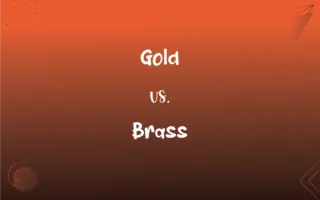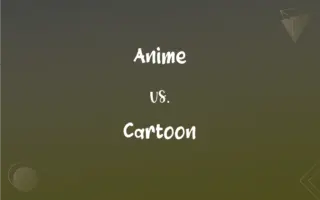Copyright vs. Trademark: What's the Difference?
Edited by Aimie Carlson || By Harlon Moss || Updated on October 19, 2023
Copyright protects original works of authorship; trademark protects brand identifiers like logos and names.

Key Differences
Copyright is a legal protection granted to the creators of original works of authorship, covering literary, musical, and certain other creative works. Trademark, on the other hand, is a protection provided to brand names, logos, slogans, and other symbols that distinguish goods or services in the marketplace.
Copyright arises automatically upon the creation of an original work, without the need for formal registration, though registration can offer additional legal benefits. Trademark rights, conversely, are established through the actual use of a particular mark in commerce, and stronger rights can be secured through registration.
Duration of protection differs markedly between the two. Copyright protections generally last for the lifetime of the author plus 70 years, after which the work enters the public domain. Trademarks, however, can last indefinitely, as long as they are in use and their registrations are maintained.
Infringement issues also vary. Copyright infringement pertains to unauthorized copying or use of copyrighted material. Trademark infringement, meanwhile, relates to the unauthorized use of a trademark in a manner that is likely to cause confusion among consumers about the source of goods or services.
While both copyright and trademark serve to protect intellectual property, their primary focus diverges. Copyright safeguards creative expressions, ensuring creators can benefit from their work, while trademark defends brand identity, preventing consumer confusion in the market.
ADVERTISEMENT
Comparison Chart
Protection Type
Original works of authorship
Brand identifiers (e.g., logos, names)
Arises
Automatically upon creation
Through use in commerce and/or registration
Duration
Author's life + 70 years
Indefinite, with continued use and maintenance
Infringement
Unauthorized copying/use of copyrighted material
Use causing likely consumer confusion
Primary Focus
Creative expressions
Brand identity and source of goods/services
ADVERTISEMENT
Copyright and Trademark Definitions
Copyright
Copyright is the exclusive legal right to reproduce a work.
She holds the copyright for her latest novel.
Trademark
Trademark identifies and distinguishes goods/services in commerce.
The company's trademark logo is recognized worldwide.
Copyright
Copyright can pertain to various creative expressions, from music to literature.
The artist retained copyright over her unique sculpture.
Trademark
Trademarks can be symbols, names, or slogans.
Their catchy slogan became a registered trademark.
Copyright
Copyright registration can provide stronger legal protection.
After finishing his movie, he filed for copyright.
Trademark
Trademarks help prevent market confusion.
Without a trademark, others could imitate their brand.
Copyright
Copyright safeguards creators from unauthorized use of their work.
Without permission, using his song breaches copyright.
Trademark
Trademark registrations can be renewed indefinitely.
They've maintained their trademark for over a century.
Copyright
Copyright duration is tied to the life of the creator.
His writings will remain under copyright for decades.
Trademark
Trademark infringement can lead to legal repercussions.
Selling products under a copied trademark is unlawful.
Copyright
The legal right granted to an author, composer, playwright, publisher, or distributor to exclusive publication, production, sale, or distribution of a literary, musical, dramatic, or artistic work.
Trademark
Abbr. TM A name, symbol, or other device used to identify and promote a product or service, especially an officially registered name or symbol that is thereby protected against use by others.
Copyright
Of or relating to a copyright
Copyright law.
A copyright agreement.
FAQs
Do I need to register to have copyright protection?
No, copyright arises automatically upon creation, but registration offers added benefits.
What's the symbol for copyright and trademark?
Copyright uses "©" and trademark uses "™" for unregistered and "®" for registered marks.
How long does copyright last?
Generally, the lifetime of the author plus 70 years.
How can I get a trademark for my brand name?
Use the mark in commerce and consider registering it for stronger rights.
Can someone else use my trademarked name in a different industry?
Possibly, if there's no likelihood of consumer confusion between the industries.
Does copyright protect facts?
No, copyright doesn't cover facts, but it can protect the expression or arrangement of them.
Are copyrights and trademarks recognized internationally?
While both have international agreements, protections often need to be sought separately in each country.
Can copyright protect my company logo?
While copyright can protect artistic aspects, trademark better protects logos as brand identifiers.
Can a trademark last forever?
Yes, if it's continuously used and registrations are maintained.
Can ideas be copyrighted?
No, copyright protects the expression of ideas, not the ideas themselves.
Can I trademark a common word?
If it's distinctive in its market context, it may be trademarked.
Can a work lose its copyright protection?
Yes, once the duration ends, it enters the public domain.
What happens if someone violates my copyright?
You can seek legal remedies, including damages and injunctions.
How does trademark benefit consumers?
It helps avoid confusion by distinguishing the source of goods/services.
How do I indicate my product's name is trademarked?
Use the "™" symbol for unregistered and "®" for registered marks.
What if someone uses my trademark in a parody?
Trademark law has exceptions for fair use, which may include parodies.
Can I copyright a single word?
Typically, no. Single words are hard to copyright but might be trademarked in specific contexts.
Do I always need a lawyer for trademark issues?
While not mandatory, legal expertise can help navigate complex trademark issues.
Can I sell my copyright?
Yes, copyright can be transferred or licensed to others.
Is a patent the same as a trademark?
No, patents protect inventions, while trademarks protect brand identifiers.
About Author
Written by
Harlon MossHarlon is a seasoned quality moderator and accomplished content writer for Difference Wiki. An alumnus of the prestigious University of California, he earned his degree in Computer Science. Leveraging his academic background, Harlon brings a meticulous and informed perspective to his work, ensuring content accuracy and excellence.
Edited by
Aimie CarlsonAimie Carlson, holding a master's degree in English literature, is a fervent English language enthusiast. She lends her writing talents to Difference Wiki, a prominent website that specializes in comparisons, offering readers insightful analyses that both captivate and inform.
































































